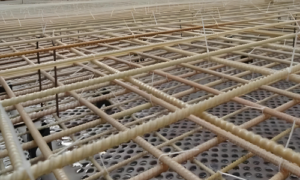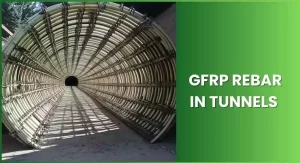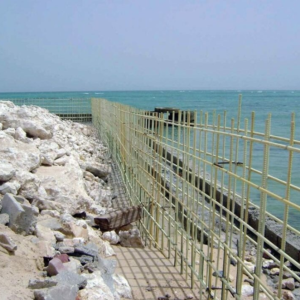Water and wastewater treatment facilities are the unsung heroes of modern infrastructure. These complex systems ensure that billions of people around the world have access to clean, safe drinking water and that our waterways remain free from pollution. But here’s a question: how do we make these essential structures not only more efficient but also more sustainable? The answer lies in an innovative material—Glass Fiber Reinforced Polymer (GFRP) rebars.
Why GFRP Rebars? The Superpower Behind Water Treatment Infrastructure

Imagine a material that’s as strong as steel but doesn’t rust, even after years of exposure to water and harsh chemicals. That’s GFRP rebar for you. Traditional steel rebars, though strong, have a significant downside—they corrode when exposed to water, oxygen, and chemicals. This corrosion weakens the entire structure over time, leading to expensive repairs and replacements. GFRP rebars, on the other hand, are inherently resistant to corrosion. This makes them the ideal choice for water and wastewater treatment facilities where the structural integrity is constantly under attack from water and chemicals.
The Versatility of GFRP in Water Treatment Facilities

Water treatment plants are complex ecosystems, each part working tirelessly to purify water and ensure it’s safe for consumption. Here’s where GFRP rebars come into play:
- Aeration Tanks: These tanks are crucial for bringing water into contact with oxygen, which helps oxidize and remove impurities. GFRP rebars provide the necessary structural support without succumbing to corrosion from constant exposure to water and oxygen.
- Reservoirs: The backbone of any water treatment plant, reservoirs store large volumes of water. Over time, these reservoirs are subjected to wear and tear from the water they hold. GFRP rebars reinforce these structures, ensuring they remain strong and stable despite the harsh conditions.
- Filtration Systems: GFRP rebars also play a role in the construction of filtration systems. These systems are exposed to various chemicals and need materials that can withstand this exposure without deteriorating. GFRP rebars, with their excellent chemical resistance, fit the bill perfectly.
Key Advantages of GFRP Rebars in Water Treatment

Now that you have a sense of where GFRP rebars are used, let’s explore why they’re so beneficial:
- Corrosion Resistance: Unlike steel, GFRP rebars don’t rust. This is a game-changer for water treatment facilities where constant exposure to water and chemicals is the norm. This corrosion resistance translates to longer-lasting structures and lower maintenance costs.
- Durability and Longevity: Structures built with GFRP rebars have a significantly longer lifespan. They don’t deteriorate over time, reducing the need for frequent repairs or replacements. In the long run, this durability leads to substantial cost savings.
- Lightweight and High Strength: Despite being lightweight, GFRP rebars possess high tensile strength. This combination means they can enhance the structural integrity of water treatment facilities without adding unnecessary weight, making installation easier and more efficient.
- Environmental Benefits: Producing GFRP rebars requires less energy compared to traditional steel rebars. This results in lower greenhouse gas emissions, making GFRP a more environmentally friendly choice. Plus, their long lifespan means fewer replacements, further reducing their environmental impact.
- Chemical Resistance: Water and wastewater treatment facilities are often exposed to a variety of harsh chemicals. GFRP rebars stand up to these chemicals, ensuring that the structural components remain intact and functional over time.
Real-World Impact: GFRP Rebars in Action
Think about it: in environments where water and chemicals are constantly at play, wouldn’t you want the most durable, reliable materials on your side? GFRP rebars have proven their worth in real-world applications. For example:
- Aeration Tanks: These tanks, which are vital for oxygenating water, benefit immensely from the corrosion resistance of GFRP rebars. The rebars ensure the tanks remain structurally sound, even with continuous exposure to water and oxygen.
- Reservoirs: GFRP-reinforced reservoirs have shown remarkable durability, maintaining their structural integrity over time. This means fewer repairs, less downtime, and more consistent water supply.
- Filtration Systems: In filtration systems, where chemical exposure is a constant challenge, GFRP rebars offer unparalleled resistance. This ensures the systems remain operational and effective for longer periods.
Embracing the Future: Why GFRP is the Way Forward

The construction industry is rapidly evolving, with a growing emphasis on sustainability and efficiency. GFRP rebars are at the forefront of this evolution. Their use in water and wastewater treatment facilities is not just a trend—it’s a smart, strategic move toward building more resilient, cost-effective, and environmentally friendly infrastructure.
So, as you look toward the future of your water treatment projects, consider the long-term benefits of GFRP rebars. They offer a unique combination of strength, durability, and sustainability that’s hard to beat. By choosing GFRP, you’re not just building for today—you’re building for the future.
Ready to Make the Switch?
If you’re ready to take your water treatment infrastructure to the next level, GFRP rebars are the solution you’ve been looking for. Let’s start a conversation about how these innovative materials can transform your projects, making them more durable, sustainable, and cost-effective. The future of water treatment is here—are you ready to embrace it?
